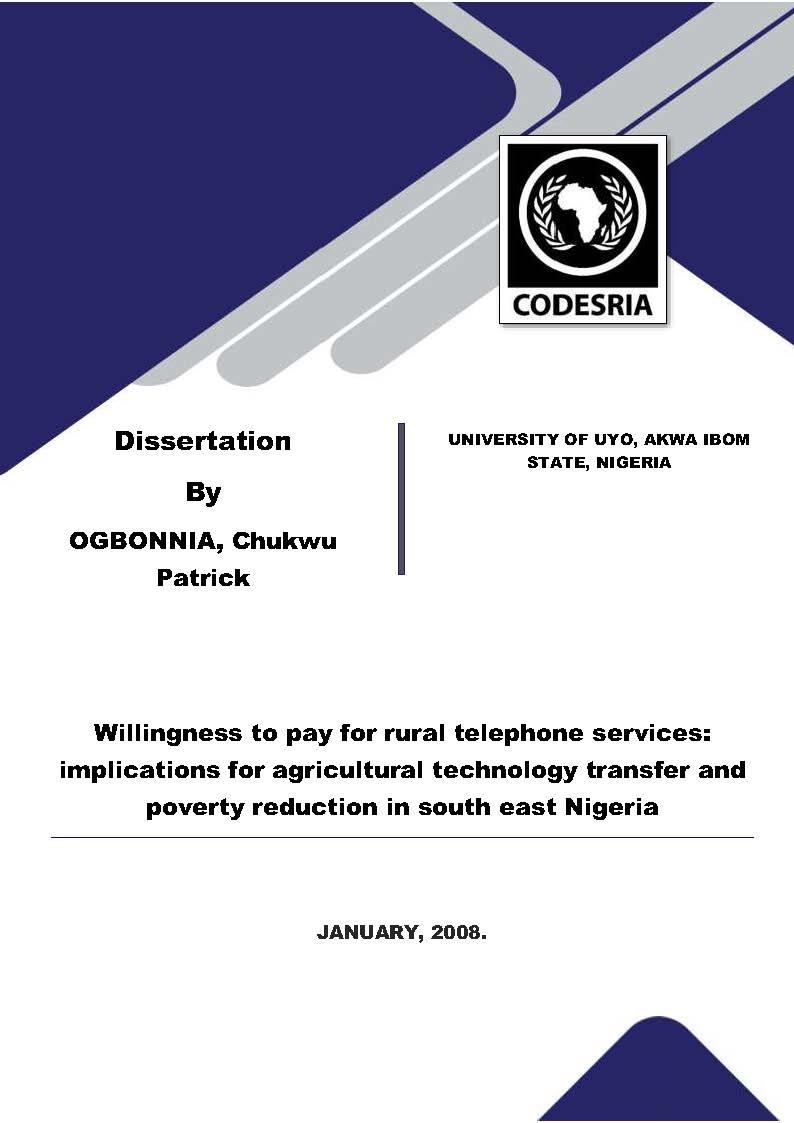Willingness to pay for rural telephone services: implications for agricultural technology transfer and poverty reduction in south east Nigeria
Keywords:
Willingness to pay, rural telephone services, agricultural technology transfer, poverty reduction, NigeriaSynopsis
This study examined the determinants of the rural people’s willingness to pay (WTP) for rural telephone services and the implications on agricultural technology transfer and poverty reduction in Southeast Nigeria. The key research problem was the inability of the telephone providers or regulatory agencies to estimate the amount the people were willing to pay for telephone
services. This led to their reluctance to extend telephone services to rural areas where agriculture is practised based on the notion that the people are unable to pay. The sample was made up of 240 agro-based entrepreneurs and 60 extension staff. Primary data were collected using structured interview schedules and well-structured questionnaires containing stochastic payment card design. The data obtained were analyzed using both descriptive (means, percentages, cross-tabulations) as well as inferential statistical tool (logit analysis). Results showed that 60.2% of the respondents were males and had higher WTP for telephone services than females. Majority of the respondents were within the age bracket of 31 – 40 years. Farming was the predominant occupation where 38.9% of them made an annual farm income of about N30000. Only about 17.7% of them had access to telephone services while 59.2% had preference for mobile telephones. The maximum, minimum and mean amounts the respondents were willing to pay per minute of telephone service were N38, N7 and N17 respectively. Respondents accepted that rural telephone where available helped them to get information on latest packages on agricultural technology. The perceived problems of agricultural technology transfer using telephone was lack of practical demonstration of technology.
Rural poverty was indicated as reduced through provision of employment opportunities for the jobless. The null hypothesis was tested using t-statistic which revealed that years of schooling and access to telephone services significantly influenced WTP at 1% level. Finally, it was recommended that both the Federal and State government should equip the agricultural officers
with modern communication technology to enhance their extension activity and that government agencies/or private telecom providers should extend telephone services to rural areas because of the rural people’s high WTP
Downloads
References
Bowker, J. and J. Stoll. 1988. “Use of Dichotomous Choice. Non-market Method to Value the Whooping
Crane Resource”. American Journal of Agricultural Economics. 70:372 – 81.
Bowman, W.M. 2002. Connecting Rural Communities: Lesson about Public Access from the American
Experience. Annual Conference and Workshop Abuja, Nigeria.
Comeron, T. and M. James. 1987. Efficient Estimate Methods for Use with Closed Ended” Contingent
Valuation Survey Data. Review of Economics and Statistics 69:267-27.
Chowdhury, S.K. 2002. Institutional and Welfare Aspects of the Provision and Use of Information
and Communication Technology in the Rural Areas of Bangladesh and Peru. Development Economics
and Polices Vol. 3.
Electronic Delivery of Agricultural Information to Rural Communities in Uganda 2001.
Foreit, K.G.F and J.R. Foreit. 2004. Willingness to Pay Surveys: For Setting Prices, For
Reproductive Health Products and Services. A User’s Manual. Revised 2004. The Population Council.
Pp 1-26
Griffin, C.C. J. Briscoe, R. Singh, R. Ranasubban, and R. Bhatia. 1995. Contingent Valuation and
Actual Behaviour. Predicting Connection to New Water System in the state of kerala, India. The
World Bank Economic Review Vol. 9:(3) P. 373 – 396.
Guasch, L.J. and R.W. Hahn. 1999. The Costs and Benefits Regulation; Implications for Developing
Countries. The World Bank Research Observer Vol. 14(1) p. 137 – 158.
Haab, Timoth, and Kenneth McConnell. 1997. A Simple Method for Bounding Willingness to Pay. Using
a Probit or Logit Model. University of Maryland. College Park. Working paper.
Hardy, P. Andrew 1980. “The Role of Telephone in Economic Development”.
Telecommunications Policy. Vol. 4 No. 4 December p. 178 – 286.
Hudson, E. Heath 1984. When Telephone Reach the Village: The Role of
Telecommunications in Rural Development. Norwood, N.J. Ablex.
Hudson, H. E. 1992. “Developing Countries’ Communications: Overcoming the
Barriers of Distance”. Forhilick/Kent Encydopedia of Telecommunications.
Vol. 4, p. 377 – 368.
Hudson, H.E. 1995. Economics and Social Benefits of Rural
Telecommunication: A Report to the World Bank.
Mamman, A.B., J.O. Oyebanji and S.W. Peters. (eds) 2000. Nigeria: A
People United, A Future Assured, Vol. 2. Survey of States. Federal
Ministry of Information, Abuja.
Meera, Shack N., J. Amita, and D.U. M. Rac. 2004. Information and
communication Technology in Agricultural Development: A
comparative Analysis of three Projects from India. Agricultural Research
and Extension Network. Network paper N. 135.
Mukherjee, C. H. White, and M. Wuyts. 1998. Econometrics and Data
Analysis for Developing Countries. Routhedge, London.
Munasighe, M. 1993. Environmental Economics and Sustainable
Development. World Bank Washington D.C.
National Research Council Board or Science and Technology for
International Development 1990. Science and Technology’s
Information Services and Systems in Africa. National Academy
Press, Washington D.C.
Organization for Economic Co-operation and Development 2003. Dev.
Centre WP 229: Providing Low Cost ICT Access to Low-Income
Communities in Developing Countries – What Works? What Pays?
Parker, Edwin B. H.E. Hudson, D.A. Dillman and A.D. Roscoe. 1989. Rural
America in the Information age: Telecommunications Policy for Rural
Development. Lanhan, M.D: University Press of America.
Pierce, William B. and N. Jequier. 1983. Telecommunications for
Development. International Telecommunication Union, Geneva.
Saunders, R. J. Warford, and B. Wellenus. 1994. Telecommunications
and Economic Development, 2nd Edition John Hopkins University
Press, Baltimore.






